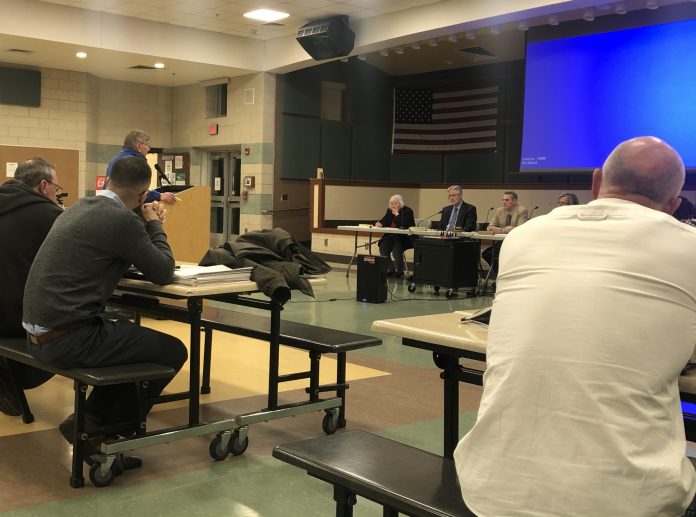NORTH SMITHFIELD – More than six years since voters in North Smithfield authorized the town to take out a $12 million bond to improve facilities, one thing was clear this week: no one has been happy with the outcome.
During a nearly three-hour discussion at a joint meeting Tuesday, Jan. 21 between the task force implementing the work and the Town Council, residents and board members exchanged blame over failings in the projects, focusing on the effort to rehabilitate the former Bushee School.
The building, which currently houses several municipal offices, the Emergency Management Agency and the North Smithfield Police Department, was slated for rehabilitation through bond financing, with a plan to dedicate the space exclusively to local police.
But according to members of the Municipal Buildings Review Task Force, there was never enough money made available to complete work needed on the structure.
Those in power when the bond process was started, meanwhile, contend that the money was only intended to complete short-term improvements and extend the building’s life. By not doing that work, they say officials have failed to satisfy a voter mandate.
They are arguments that have been repeated between opposing town parties for several years. But in an interview Tuesday of the architect who put out bid specs for the project, some information came as a surprise to councilors who voted to approve documents for the project two years ago.
“The budget doesn’t meet the appetite. It’s as simple as that,” said Mark Saccoccio of Cranston-based firm Saccoccio & Associates of funding for the former school. “You’ve had many consultants tell you that building has reached its useful life.”
Councilors voted in February of 2018 to have Saccoccio develop “the scope and drawings to match” the town’s $900,000 budget for the project, according to minutes from the meeting.
But Saccoccio said he met with the police chief before developing a detailed request for proposals, a roughly 500-page document that went out to bidders.
“There was a lot of discussion on what they would accept as the minimal amount of work,” Saccoccio said of his meeting with the chief. “The resulting document is what was put out.”
Bids came in at around $2.5 million, as they had in a previous request for proposals for the building put out in 2016, and well beyond the $900,000 budget.
John Flaherty, who was the Town Council president at the start of the process in 2012, has noted that the town’s plan for bond-financed work was developed with input from nearly every municipal department, as well as residents. At the time, bond counsel recommended that funding should not exceed $12 million, and all involved made concessions, reaching compromises on their hoped-for improvements.
“The job was dictated by the available resources,” Flaherty said Tuesday.
Officials had initially hoped to complete somewhat extensive work at what’s currently known as the town Annex. But bids first put out in 2016 came back well over budget, and after an election put new councilors in charge that year, the board – known then as the Public Buildings Improvement Commission – was told to cease and desist their work.
John Beauregard, who was on the Town Council when the original board was dismissed, and has since taken a position on the MBRTF, read minutes from a PBIC meeting held just before the 2016 decision.
“It does paint a picture of the PBIC in kind of a disarray,” said Beauregard. “These minutes – the only I could find of their last four meetings – say it would be a waste to put money into Bushee.”
“The root of all evil on this project is the bond itself.” Beauregard said.
Councilor Douglas Osier questioned when the scope of work in the bid Saccaccio developed years later had changed.
“I keep hearing that the police wanted ‘X,’or the police wanted ‘Y.’ It’s an obligation. It’s not a wish list. It was the will of voters,” said Osier. “I’m just curious where that direction came from.”
Town Council President Paul Vadenais pointed out that the MBRTF is made up of several building professionals, who regularly complete such large-scale projects and understand the requirements. Member David Chamberland, for one, serves as senior vice president of Carpionato Group, Inc. and Greene Const. Inc., and has decades of experience in the industry.
Group members have repeatedly stated that work done by the PBIC before they took over the project was inadequate.
Resident Michael Clifford, however, contends that Saccoccio made few changes to the original bid request for a full renovation put out by the PBIC’s architect, despite telling councilors that 2018 bid specs would focus purely on health and safety issues.
“I would like to know what the purpose would be of developing a scope of work that we knew we couldn’t afford,” Clifford said. “We knew what a full renovation would cost in 2016.”
Vadenais said that his board might have instead abandoned the idea of doing any part of the project without adequate funding, but the town had already taken out the money.
“The town borrowed that money before they even had a bid,” said Vadenais. “I personally spoke up and said borrowing money when you don’t know the scope of the project is the wrong thing to do.”
“The task force recommendation would have been that you do nothing, but we couldn’t do that,” Vadenais said.
Vadenais said that Saccaccio’s request for bids was submitted with plans to again meet with the chief, and eliminate items from the scope of work once costs were fully known. But the gap between what was needed and the final price, he said, was too large to make that possible.
“Our original process was to meet with the police chief once we had a solid number, but it was too much to make up,” Vadenais said.
That news came as a surprise to Councilors Claire O’Hara and Paul Zwolenski, who admitted Tuesday that they believed the bid specs they voted to approve in 2018 were for a reduced scope of work.
Clifford said the problem was just one example of how the process under the MBRTF has lacked transparency.
“I’ve never heard before tonight that the scope of work was expanded because the police department wanted other things,” said Clifford. “To make believe this was conveyed to the council – give me a break. What an exercise in futility and a waste of money.”
“You weren’t told because they didn’t want to tell you,” Clifford said to the councilors. “This is a joke and I’m ashamed that you think it’s appropriate to pull this kind of maneuver.”
Frustration on both sides became clear as arguments continued past 10 p.m.
“This was a project that was flawed from day one,” said Chamberland. “I’m not sure I even want to continue.”
“I’m disgusted, and you let them speak tonight over and over- this group of bandits,” Chamberland added of the MBRTF’s critics.
Osier asked what had to be done to get some type of project for the Annex back on track.
“I will stay on. I will make a recommendation,” said Chamberland. “But I won’t put up with that crap. This is just harassment.”
“$900,000 isn’t going to buy you a lot,” he added. “But if you’re going to spend the money, as a taxpayer, I recommend you spend it wisely.”
The MBRTF is expected to present their recommendation for work on the building at a council meeting scheduled for Monday, March 16.







